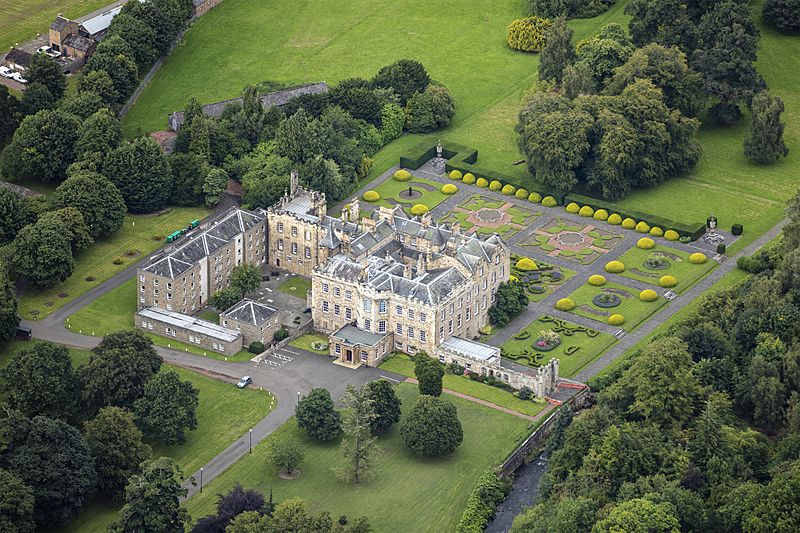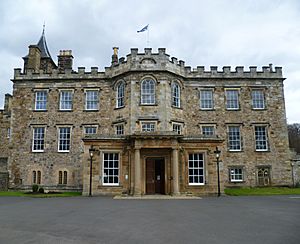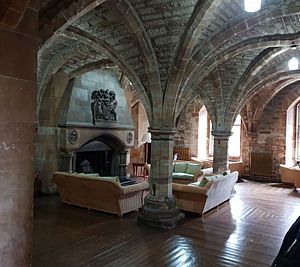Newbattle Abbey facts for kids
|
|
|
| Monastery information | |
|---|---|
| Order | Cistercian |
| Established | 1140 |
| Disestablished | 1587 |
| Mother house | Melrose Abbey |
| Diocese | Diocese of St Andrews |
| Controlled churches | Bathgate; Clerkington; Cockpen; Eassie; Heriot; Masterton; Newbattle |
| People | |
| Founder(s) | David I of Scotland |
| Important associated figures | Thomas Livingston |
Newbattle Abbey (Scottish Gaelic: Abaid a' Bhatail Nuaidh) was once a Cistercian monastery. A monastery is a place where monks live and work together. This one was near the village of Newbattle in Midlothian, Scotland. Over time, it changed from a religious home to a grand house, and then to a college.
The Abbey's Early Years
Newbattle Abbey was started in 1140. Monks from Melrose Abbey came to build it. King David I and his son Henry supported its creation. The abbey's church was officially opened in 1234.
The abbey was built in a beautiful valley. It was located along the River South Esk. Rudolph was its first abbot, which is like the leader of the monks. He worked hard to build the abbey. The church was very long, about 240 feet. At one point, about 80 monks and 70 lay-brothers lived there. Lay-brothers helped with daily tasks.
Growth and Importance
Newbattle Abbey quickly became successful. It was known for its well-behaved monks. Many monks from Newbattle became important bishops. The kings of Scotland liked the abbey very much. They often visited and gave generous gifts to the monks.
Coal Mining and Trade
One of the main ways the abbey earned money was through coal mining. The monks of Newbattle were among the first coal miners in Scotland. The earliest mention of coal in Scotland is linked to them. An Earl of Winchester gave them a coal mine.
In 1526, King James V allowed them to build a harbour. This harbour was at Morrison's Haven. This led to the creation of Aitchison's Haven Lodge. This was a group for stonemasons. In 1531, the Abbot of Newbattle made a deal. He worked a coal mine at Prestongrange. This helped drain water from nearby mines.
Challenges and Changes
Newbattle Abbey faced many attacks from English forces. In 1385, the monastery and church were burned down. The monks either ran away or were taken. It took 40 years to fix the damage. Later, in 1544, part of the abbey was destroyed again. This time it was by the Earl of Hertford. The church was mostly affected.
During the Scottish Reformation, there were only a few monks left. The Reformation was a big religious change in Scotland. The remaining monks were given money by Mark Kerr. He was in charge of the abbey's property. Mark Kerr changed to Protestantism. This allowed him to keep the land around the abbey. His son, also named Mark, became Lord Newbattle in 1596. He later became the Earl of Lothian in 1606.
Today, the abbey site is a scheduled monument. This means it is a protected historical place. It includes old burial grounds and parts of the chapel.
Newbattle as a Stately Home
Part of the old abbey was turned into a large house. This house is still the main part of the building today. It includes the lower part of the monks' sleeping area. This area is still in good condition.
The house was changed and rebuilt over many years. Famous architects like John Mylne and William Burn worked on it. The drawing room is one of Scotland's most beautiful rooms. It was decorated around 1870. The chapel was made in the 1800s. It is in a vaulted room that might be from the original abbey. The chapel has a font from the 1500s. It also has a lovely wooden floor. The wood came from the estate. The library is made of oak wood. It has a molded ceiling from the 1600s.
In 1822, King George IV visited the abbey. He came during his tour of Scotland. The King's Gate was built to honor his visit.
Newbattle as a College
Newbattle Abbey was the home of the Marquesses of Lothian for many years. In 1937, Philip Kerr, 11th Marquess of Lothian, gave it to the nation. He wanted it to be used as a College of Education.
The college was set up for adults returning to school. It was managed by trustees from Scotland's four oldest universities. New buildings were added in the 1960s for students to live in. The Scottish Education Department provided funding.
In 1987, the government planned to stop funding the college. This threatened its closure. However, new ways of getting money were found. This allowed the college to continue its important work.
People Buried at the Abbey
See also
 In Spanish: Abadía de Newbattle para niños
In Spanish: Abadía de Newbattle para niños




